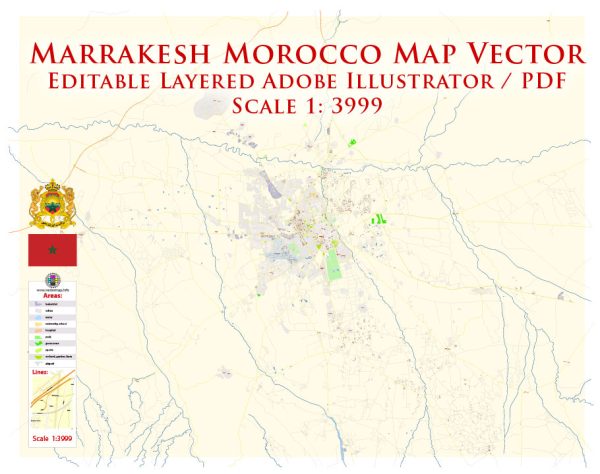Marrakesh, located in the western part of Morocco, is a city known for its rich history, vibrant culture, and stunning architecture.
Vectormap.Net provide you with the most accurate and up-to-date vector maps in Adobe Illustrator, PDF and other formats, designed for editing and printing. Please read the vector map descriptions carefully.
Here is a detailed description of some of the historic places, buildings, streets, and squares that contribute to the city’s unique charm:
- Medina of Marrakesh (Old Town):
- The heart of Marrakesh is its historic Medina, a UNESCO World Heritage Site. The Medina is a maze of narrow alleys, bustling souks (markets), and vibrant squares. The walls surrounding the Medina were built in the 12th century, and the area is known for its well-preserved traditional Moroccan architecture.
- Jemaa el-Fnaa Square:
- Jemaa el-Fnaa is the main square in the Medina and one of the liveliest in Africa. During the day, it’s a bustling market with street performers, food stalls, and snake charmers. As evening falls, the square transforms into a vibrant hub of entertainment, with storytellers, musicians, and food vendors creating a lively atmosphere.
- Koutoubia Mosque:
- This mosque is one of the most significant landmarks in Marrakesh. Built in the 12th century, the Koutoubia Mosque features an impressive minaret that dominates the city’s skyline. It is a fine example of Almohad architecture and is not only a religious site but also a symbol of Marrakesh.
- Bahia Palace:
- Built in the late 19th century, the Bahia Palace is a beautiful example of Moroccan and Islamic architecture. The palace boasts stunning gardens, intricate tilework, and ornate rooms. It was intended to be one of the greatest palaces of its time and served as a residence for the Grand Vizier’s concubines.
- Saadian Tombs:
- Dating back to the 16th century, the Saadian Tombs were rediscovered in 1917 and contain the mausoleums of members of the Saadian dynasty. The tombs are known for their beautifully decorated rooms and the craftsmanship of the stucco and tilework.
- Majorelle Garden:
- Designed by the French painter Jacques Majorelle in the 1920s, this garden is a peaceful oasis with exotic plants, vibrant blue buildings, and fountains. The garden was later owned by Yves Saint Laurent and Pierre Bergé, and their ashes were scattered here.
- El Badi Palace:
- Built in the 16th century by Sultan Ahmad al-Mansur, El Badi Palace was once a lavish complex with grand courtyards, gardens, and a massive pool. Today, the ruins offer a glimpse into the opulence of the Saadian dynasty.
- Mellah (Jewish Quarter):
- The Mellah is the historic Jewish quarter of Marrakesh, known for its narrow streets and unique architecture. It features synagogues, historic houses, and a distinct atmosphere that reflects the coexistence of different communities in the city.
- Dar Si Said Museum:
- Housed in a beautiful palace, the Dar Si Said Museum showcases Moroccan arts and crafts. Visitors can admire a diverse collection of textiles, ceramics, jewelry, and traditional wooden artifacts.
- Rue Mouassine:
- This charming street in the Medina is lined with traditional shops, boutiques, and cafes. It’s a great place to explore, shop for souvenirs, and experience the local atmosphere.
These historic places, buildings, streets, and squares collectively create the unique character of Marrakesh, offering visitors a journey through centuries of history and cultural richness.


 Author: Kirill Shrayber, Ph.D.
Author: Kirill Shrayber, Ph.D.